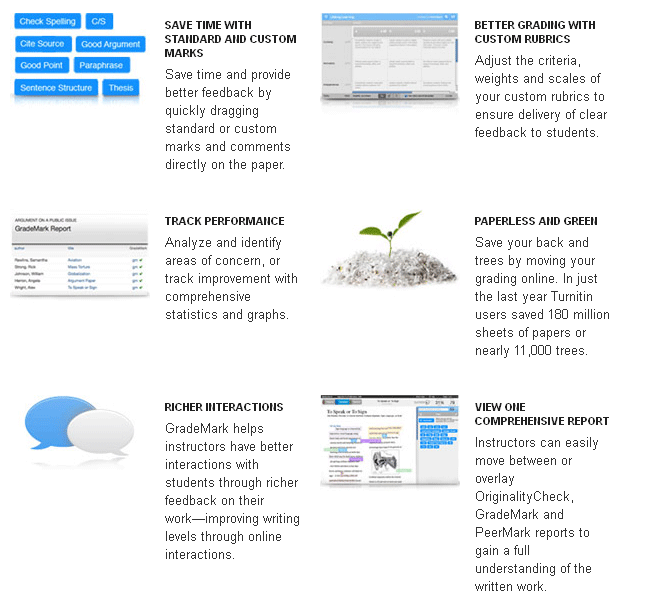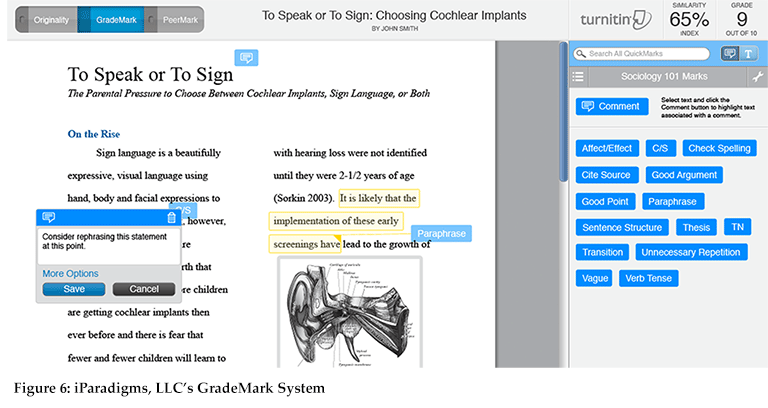The Monetary Rewards of Cultural Anxieties
It's interesting to note that John Barrie studied rhetoric as an undergraduate along with neurobiology (“iParadigms Board”). Perhaps his rhetorical training equipped him with the skills needed to target the anxieties of various groups who helped make Turnitin the leading plagiarism detection technology today. Indeed, the overwhelming message of all of the branches of iParadigms, LLC is the alleviation of anxieties. Through these messages, technology is promoted as the solution to pedagogical worries, fears of plagiarizing, and concerns about teaching in an age of budgetary cutbacks. In particular, plagiarism detection technologies are touted as a panacea that will address not only our fears about plagiarism itself, but also anxieties about our teaching, our students, and our role in the composition classroom.
The site touts the following benefits afforded by subscribing to its service. This list is paraphrased from the various marketing materials Turnitin.com showcases on its site:

Sounds fantastic, yes? We must question our acceptance that technologies like Turnitin can deliver all of what they have promised and more, particularly given the utopian ideals of the values the site professes. Much like Sheils’ (1975) “Why Johnny Can’t Write” reflected middle-class parents’ apprehensions about social status, meritocracy, and their children’s futures (Trimbur, 1991, pp. 278-279), today’s Internet plagiarism crisis is a label that taps into a host of anxieties about twenty-first century higher education. Amid budget cuts that have reduced entire programs, rising course caps, and the constant mantra to do more with less, the specter of Internet plagiarism and its supposed resolution, plagiarism detection technologies, are attempts to resolve these concerns, as Trimbur (1991) described, “magically” (p. 279). After all, the benefits described above sound like a list of pedagogical wishes granted by a technological genie.
iParadigms has smartly relied on positives rather than negatives in its marketing messages; the underlying anxieties that necessitate the use of Turnitin, GradeMark, PeerMark, and so on are unstated. When considering these testimonials critically, though, it is necessary to focus on the unstated anxieties that form the heart of iParadigms' brand message. This focus better allows us to analyze whether or not iParadigms technologies can even serve as a solution to those anxieties. For instance, Turnitin's website lists seven features of GradeMark, its paperless grading service; six of those features are shown below. What pedagogical anxieties do these features reveal?

The first two features, ”save time with standard comments” and ”better grading with custom rubrics,” both speak to pedagogical anxieties about working with student papers. Despite composition research that has argued that more copious commentary, especially directive commentary, does not necessarily lead to better student writing, many of us still harbor concerns that we may not be giving enough feedback to student writers.
Yet the examples shown in the screenshot below seem arhetorical enough that they would be near useless: WC; C/S; awk; thesis. Was the thesis strong? Did it set up a discussion that the student later developed in his or her paper? (Did the assignment even require a thesis?) While the instructor can elaborate on these pithy comments, that takes time, as the screenshot below illustrates, and the kind of comments that truly speak to the individual writer (rather than generic commentary that is heavily mechanics-based) don't lend themselves well to drag-and-drop standard comment technologies anyway.

The feedback options embedded in GradeMark may indeed save paper, but they don't immediately seem to save time, lead to better student writing, and (as promised above) provide better interactions with students through richer feedback, unless richness is simply copiousness in mechanics-focused notes.
index ![]()
![]() the specter of internet plagiarism
the specter of internet plagiarism ![]()
![]() the turn to turnitin.com page 1
the turn to turnitin.com page 1 ![]() page 2
page 2 ![]() page 3
page 3 ![]() page 4
page 4 ![]() page 5
page 5 ![]() page 6
page 6 ![]()
![]() authorship and anxiety page 1
authorship and anxiety page 1 ![]() page 2
page 2 ![]() page 3
page 3 ![]() page 4
page 4 ![]() page 5
page 5 ![]() page 6
page 6 ![]()
![]() critical assessment
critical assessment ![]()
![]() references
references

